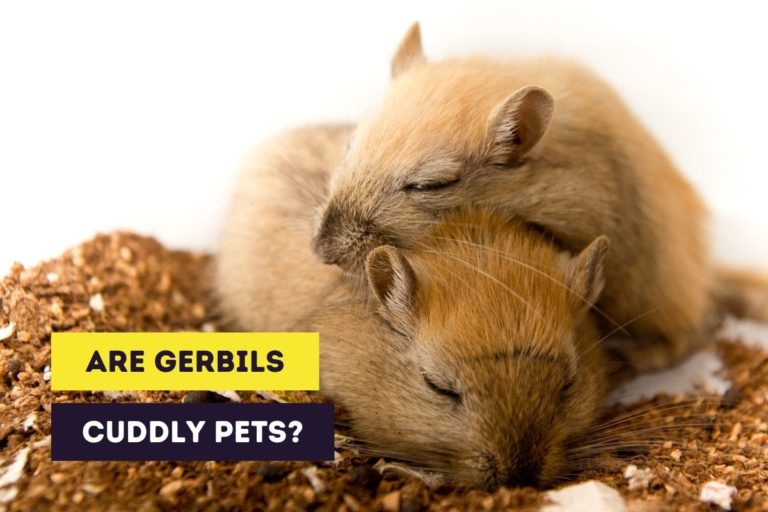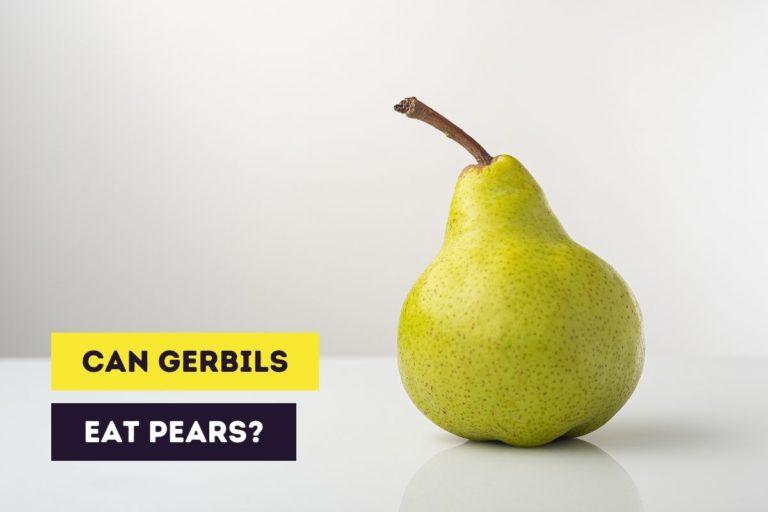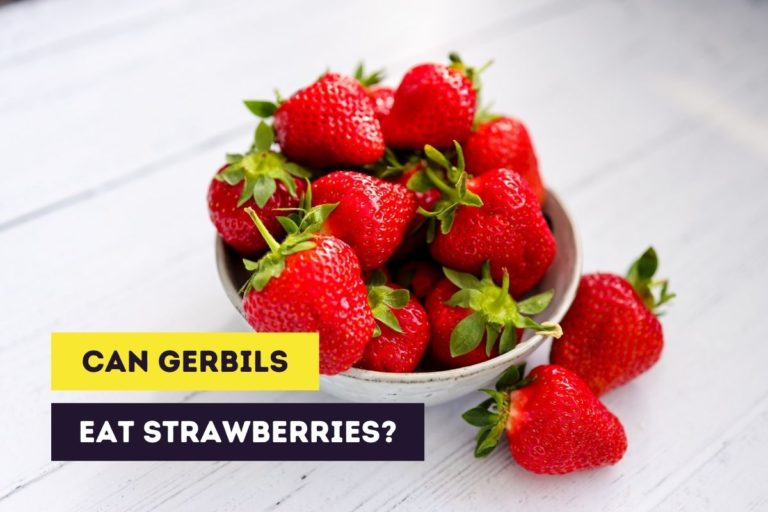Gerbil Care Guide | How to Treat Gerbils? (With FAQ)
You’ve bought a pair or small group of gerbils and are ready to start caring for your little pets. Gerbils are quite low-maintenance pets and their care is comparable to that of other pets. Because of their short lifespan, crepuscular nature, and generally friendly character, they are generally good pets for most people.
Gerbil care consists of six pillars. You need to handle them properly and provide a nutritional diet. Gerbils also need to be housed in a large enough cage and get enough enrichment. You will also need to clean their cage at least once a month and need to get them examined each year by a vet.
This guide concerns the most popular kind of gerbil that’s being kept as a pet, the Mongolian gerbil. However, a lot of the content is also applicable to care for the fat-tailed gerbil. This kind of gerbil is less popular and you often need a special permit to keep it.
Although I won’t mention it further in this guide, the most important (implied) aspect of gerbil care is that gerbils should be kept in a small group. You should at least keep a pair of gerbils to keep them healthy and happy.
There are some cases where you can (temporarily) keep a gerbil alone. However, if you want to keep only one pet then the Mongolian gerbil isn’t the right one for you.
To give your gerbils the best possible care, it’s important to learn all aspects of gerbil care through answers on the most commonly asked questions. So, let’s start learning everything there is to know about gerbil care right now!
This site contains affiliate links to products we recommend and use ourselves. We may receive a commission for purchases that you make through these links. If you’re interested in learning more about our affiliate links, please visit our (affiliate) disclaimer.
Handling Your Gerbils
Most people that buy a pet want to handle and bond with it and most gerbil owners want to be able to hold their gerbils. However, there are some pets that aren’t affectionate or cuddly towards humans.
Can gerbils be handled?
Gerbils can be held when they trust you. Let your gerbil come to you and wait until it’s in your palms. Don’t squeeze your gerbil and be gentle when you handle it. Gerbils are very active creatures and won’t like to be held for a long time. They would rather explore their surroundings.
Are gerbils cuddly?
Gerbils aren’t cuddly pets, but they do show affection in other ways. A gerbil is a very active (sometimes even hyperactive) pet that can’t stay still for a long time. They would rather explore their surroundings and run around instead of being cuddled. Only some gerbils will like to be cuddled.
How do you handle a gerbil?
You should always handle gerbils carefully. They’re small and active and won’t sit still for a long time. The best way to pick up a gerbil is by forming a cup with both your hands. Then scoop your gerbil up. Never grab a gerbil by its tail. Your gerbil will lose its tail and it won’t grow back.
If you’re not comfortable with picking your gerbil up with your hands, you can also try to get it into a cup or bowl and place your hand on top of it to prevent your gerbil from escaping.
Be careful! Your gerbil might want to jump or run on your arm. Make sure that it can’t fall from a large height because this can cause serious injuries.
Housing Gerbils
Gerbils need to be kept in a large enough cage (also take a look at our gerbil cage guide). A lot of gerbils, and pocket pets in general, are not kept in appropriate cages. It’s important to understand that gerbils have a large territory in the wild and that they’re burrowing animals that need enough space to create tunnels.
What kind of cage do gerbils need?
Because gerbils need to have a thick layer of substrate to create tunnels, there are only a few cage types suitable:
- wire or mesh cage with a deep base
- tank with a cage topper
- gerbilarium
A gerbilarium is a glass (sometimes plastic) tank with ventilation through a screen on top of it. It’s the most suitable kind of cage for gerbils. They prevent that substrate or bedding is kicked out of the cage and are usually large enough to create a deep layer of substrate for your gerbils to create a burrow and tunnels. Sadly, there aren’t a lot of gerbilaria being sold and most are custom-made.
A tank (aquarium) with a cage topper can be a suitable cage for gerbils if the tank is deep enough so bedding can’t be kicked out. You can find some great cage toppers made out of metal. These toppers can be used on top of old or new tanks. You can also buy a combination of the two in stores and online.
A wire cage is the least suitable for gerbils because most bases (pans) are not deep enough and substrate (bedding) can easily be kicked out of the cage. However, if you can find a wire cage with a base that is at least 20 cm (8″) and don’t mind cleaning up more often, a wire cage can be used.
What size cage do gerbils need?
There’s a lot of discussion on the minimum cage size for gerbils. A pair of gerbils should have at least 2,500 cm² of floor space and a minimum height of 30 cm (12″). This equates to a volume of at least 20 gallons. In some regions, you might need a larger cage because of local regulations.
Can gerbils live in plastic cages?
Gerbils love to chew and can chew through plastic very easily. Most plastic cages are not suitable for gerbils. If a gerbil can find a starting spot to chew on the plastic, it can create a hole and escape. A glass cage with a metal frame is better to prevent your gerbils from escaping.
What kind of substrate (bedding) do gerbils need?
The best substrate (also called bedding) for gerbils is a plant-based substrate that is absorbent, controls odors, is non-toxic, and is good for creating tunnels. It’s best to combine different substrates such as aspen wood shavings, a paper-based substrate, and hay.
How much substrate (bedding) do gerbils need?
You need to provide a thick layer of substrate so your gerbils can create tunnels and a burrow. It’s recommended to have a layer of substrate between 20 and 30 cm (8″ to 12″). A deeper layer that’s up to 70 cm (27.5″) is more preferable but is often not possible unless in custom made gerbil cages.
Feeding Your Gerbils
An essential part of gerbil care is giving a proper diet and water to your gerbils. A complete gerbil diet provides all nutrients to your gerbils. You don’t need to supplement a complete diet, although you can add certain foods as a treat.
What should you feed your gerbils?
Gerbils are omnivores and will eat on both animal and plant matter in the wild. Pet gerbils should be fed a lab block/pellet food and/or seed mix targeted at gerbils. These contain all nutrients that are necessary to keep your gerbil healthy. Vegetables, fruits, and other treats can also be given.
In the wild gerbils will eat seeds, nuts, herbs, grasses, roots, vegetables, fruits, and insects. The diet consists mostly of plant matter like seeds and grasses.
Vegetables and fruits can usually be given but only once or twice a week. Most vegetables and fruit contain a lot of water and this can cause health issues, like diarrhea. You can also give food like nuts, seeds, and insects (mealworms and crickets) as a treat.
Watch out for toxic or unhealthy food for gerbils. You can find a non-exhaustive list of this food in our more extensive gerbil diet guide.
How often should you feed gerbils?
Gerbils are crepuscular pets and they should be fed each day either in the morning or evening. Some sources recommend dividing the total amount of food and feeding it 3 or 4 times a day. It’s true that gerbils need to have food available ad libitum (without restriction).
However, I would recommend feeding once and scattering the food around in the cage for your gerbils to forage. If you feed a combination of pellet food and seed mix, you should divide the total amount of food you give in half: half should be pellet food and half should be seed mix.
You should only give other food, like non-leafy vegetables and fruits, once or twice a week as a treat. Water should be available at all times although gerbils don’t drink that much.
How much should you feed your gerbils?
The main diet of gerbils should consist of pellet food and/or seed mix. You should feed your gerbils one tablespoon of food per gerbil. This is between 10 and 15 grams of food each day. Treats, like fruit and mealworms, should be given occasionally in small amounts (maximum size of a gerbil head).
How much water do gerbils drink?
Gerbils in the wild live in a quite arid environment and can go for extended periods without water. But in captivity, gerbils need access to fresh water at all times. A single gerbil will drink up to 150 ml per month (around 5 ml daily) depending on the age, temperature, and exercise levels.
Enrichment for Gerbils
Toys and equipment
Gerbils need enrichment in their cage to stay active and to prevent boredom. You can provide chew toys, ropes, ladders, and other kinds of toys. It’s best to provide wooden toys and gerbils will chew through plastic and can ingest it. Some enrichment equipment that should be standard in any gerbil cage is:
- chew toys, like branches of safe wood
- hides
- seesaws
- hammocks
- rope toys
If you want to create an extra space for your gerbils to burrow you can also create a digging box that is accessible from the top.
Exercise
Gerbils also need to get enough exercise and the best way to provide this is with an exercise wheel (or a hamster ball). An exercise wheel made of metal or wood is better than a plastic one. The wheel should have:
- a diameter of at least 20 cm (8 inches) although larger is better
- no bare rungs (solid floor)
- a solid back
Your gerbils should be able to run with a straight back. If you want to prevent a “wheel tail” you’re best option is a flying saucer.
Hamster balls are not recommended. You can only use a hamster ball if the gerbil likes using it. The balls should have a diameter of at least 18 cm (7 inches), although larger is again better.
Cleaning the Gerbil Cage
A gerbil cage needs to be cleaned regularly to prevent the buildup of bacteria. A thorough cleaning will prevent smelly gerbil cages. Gerbils themselves are not smelly and often it’s just the cage that smells.
How often do you need to clean the cage?
You should spot clean the cage daily and remove uneaten food the day after you fed it. Some foods get bad faster and need to be removed a few hours after giving them. Gerbils urinate only a little. The urine is highly concentrated so cleaning is usually only needed once a month.
A lot will depend on the size of the gerbil cage and the number of gerbils you keep. For a pair of gerbils, you can usually only spot clean and clean thoroughly once a month. If you notice that the cage smells, it might be necessary to clean the cage more often or refresh a part of the substrate.
The thorough (monthly) cleaning will consist of:
- clearing out the entire gerbil cage
- clean and disinfect the cage
- clean the decorations, toys, food bowls, water bottle
- refresh the entire substrate and bedding
An exception you’ll need to know about is the sand or dust bath. Gerbils use a sand bath often as a toilet area. It’s recommended to spot clean this sand bath and clean it more often by changing the sand regularly (at least once a week).
Where do you keep your gerbils while cleaning?
You should keep your gerbils in a temporary cage or carrier while you clean and disinfect the cage. The cleaning process takes around 30 minutes from start to finish. This means that your gerbils don’t need to spend a long time outside of their cage.
You can use a small (transport) cage or faunarium to keep your gerbils in while you’re cleaning. Make sure that they’ve got enough chew toys in it and a layer of substrate.
Can you wash a gerbil?
A gerbil doesn’t need to be washed with water. Wild gerbils don’t come in contact with a lot of water. Instead, they use sand to keep their coats clean. A sand bath should be provided for gerbils to roll in and keep their fur healthy and dirt-free.
Keeping Your Gerbils Healthy
The last important aspect of gerbil care is keeping your gerbils healthy. Gerbils have a short lifespan compared to some other pocket pets (a gerbil that’s older than 2.5 years is already a senior). But you want to keep your gerbils healthy and live as long as possible.
There are some health issues that your gerbils can get. It’s important to recognize the symptoms and get veterinary help if needed. A regular checkup each year is certainly recommended.
Common health issues
Most health issues are a result of improper care but there is also genetics that comes into play. If you notice that your gerbil has health problems it’s best to get help from a vet.
However, seizures are most common in young gerbils (under six months) and there’s not much you can do about them. Seizures in gerbils don’t usually require medical treatment. As gerbils grow up the likelihood and severity of seizures decrease.
The most common health issues that gerbils can get are:
| Health Issue | Symptoms |
|---|---|
| seizures | trembling twitching ears and whiskers unsteady severe shaking stiffness |
| kidney disease | frequent urination severe thirst bloody or cloudy urine depression |
| dermatitis | sore nose hair loss on face redness on face |
| pneumonia | coughing discharge from nose wet nose breathing noises |
| intestinal problems | diarrhea |
| cancer | lump swelling |
| Tyzzer’s disease | depression (apathy) rough hair coat loss of appetite dehydration diarrhea |
Finding a good vet for your gerbils
For some pets, it’s necessary to get them vaccinated against diseases. Gerbils are an exception and don’t need to get vaccinations. They do still need to get a regular (annual) checkup by a vet. You’ll also need a vet when your gerbils are sick.
You don’t want to have to look for a vet in emergency situations. It’s much better to already know a vet or animal hospital in your vicinity where you can seek advice and help. Since gerbils are popular as pets there’s a high chance that a vet knows how to examine and treat a gerbil. A specialized vet will not be necessary in most cases.
It’s important to keep the number of your vet nearby. Write the telephone number down and keep it where you can find it easily (for example, on the fridge). You can also just save the number in your phone.
If your vet isn’t available 24/7 you should also find the address of the nearest animal hospital with emergency service (that also treats gerbils). You can find such hospitals (in the USA) through the website of VCA or Emergency Vets USA.
Emergency consultations and surgery can cost up to $200. Sometimes it can be a good idea to get a pet assurance (especially if you’ve got a lot of gerbils) but otherwise you could set aside $10 each month for such unforeseen costs.
To Get You Started
Before you bring your gerbils home you’ll need to already have a gerbil cage or gerbilarium ready for them. The entire cage should already be set up with everything in it (substrate, bedding, water bottle, food dish, toys,…). You can find everything you’ll need on our shopping list for gerbils.
As you bring your gerbil home you need to take the first big step in caring for your gerbils: letting them adjust to you and their new environment. This is an easy but also an extremely important step.
Gerbils (especially young ones) are prone to seizures when they’re in a new environment. It’s your job to make your gerbils feel at home as soon as possible.
How to let your gerbils adjust to their new home?
Just like any animal that you bring home you should let your gerbils adjust to their new environment before interacting with them. This doesn’t mean that you can’t touch them or feed them. It does mean that you should limit handling to a minimum and that you shouldn’t open the cage several times a day.
You’ll still have to have some basic interactions that you can’t do without:
- placing the gerbils from their transport cage into their new gerbil cage
- feeding your gerbils and giving fresh water
However, you should have already put in food in the cage before you put them into the cage. The water bottle should already be filled. This way you only have to place them in their new cage the first day and can leave them exploring their cage the next few hours.
If you’ve got a pair of gerbils they will usually already be used to each other and form their own clan. If they already form a clan they can be put in the cage together. Always ask the seller if the gerbils are used to each other and have bonded. If not, it’s important to introduce them to each other (before placing them into one cage).
Gerbils are animals that depend a lot on their senses. You can fasten the process of adjusting to their new home by getting a little bit of the bedding in their old cage. Place this old (but not dirty) bedding in their new home and mix it with fresh bedding. This might not always be possible and is not a necessity as most gerbil owners will just use fresh new bedding.
How to let your gerbils adjust to you?
The first day should only consist of placing your gerbils into their new home and letting them explore it. In the next few days, you should establish a routine that your gerbils can get used to.
Limit the interaction to feeding your gerbils and giving fresh water each day. You should softly speak to your gerbils while replacing their food and water so they can get used to your voice.
If you notice that your gerbils are interested in you, you can start the next steps in bonding with your gerbils. The first signs of interests will be:
- your gerbils don’t run and hide when you open the cage door
- when you’re coming near the cage your gerbils come sniffing
Gerbils are curious pets and are friendly in nature. You can easily take the first steps in bonding within the first two weeks. To start bonding and getting your gerbils used to close interaction with you, you should:
- open the cage door and reach with your hand in it
- let your hand hang in the cage for a few minutes
- let your gerbils explore your hand (don’t grab it!)
- slowly take your hand outside of the cage and close the door
You can also use treats (such as sunflower seeds) to improve the bonding process: give a treat with your hand. Be careful that your gerbil doesn’t bite in your hand.
This is just the first step. You can now slowly get your gerbils to adjust to being handled.
Recommended Products
If you want to give the best care to your gerbils I would highly recommend the following products:
| Gerbil Supplies | Recommendation |
|---|---|
| Gerbil cage | Living World Green Eco Habitat |
| Paper-based bedding | Carefresh Small Pet Bedding |
| Hemp-based bedding | Dr. Hemp All Natural Pet Bedding |
| Food bowl | OMEM food bowl |
| Water bottle | Oasis Water Bottle |
| Pellet food | Oxbow Essentials Hamster Food and Gerbil Food |
| Seed mix | Versele-Laga Nature Gerbil Food |
| Healthy treats | Fluker’s Freeze-Dried Mealworms |
| Toys | Niteangel Natural Living Tunnel System, Small Animal House eCOTRITION Snak Shak Edible Hideaway |
| Exercise wheel | OMEM Hamster Exercise Wheel |
| Flying saucer | Metal Flying Saucer Wheel |
| Hamster ball | Kaytee Run-About 7″ Hamster Exercise Ball, Moon Glow |
This is just a short list of the recommended supplies for your gerbils. For a full and comprehensive list of all supplies (including cleaning supplies), you should take a look at our shopping list for gerbils.
Related Questions
Should I cover my gerbil cage at night?
Gerbils are crepuscular and are active both during the day and at night. Covering the cage won’t do much to their activity levels. It can give them a sense of safety, but this is debatable. The only benefit you could get from covering the cage is that (soft) sounds will be less audible.
Do gerbils try to escape?
Gerbils don’t try to escape but can chew on plastic and wood, which can cause holes in a cage. Since gerbils are curious they can venture outside the cage in such instance. The burrowing behavior isn’t to be confused with them trying to escape. It’s their natural behavior.
Are gerbils high maintenance?
Gerbils are not high-maintenance pets. They do require basic care such as daily feeding and refreshing the water, and they do need a cage, bedding, and some cage accessories. Like any kind of pet, they need to be taken to a vet when sick. However, they don’t need particular special care.
Want to Learn More?
If you want to learn more about gerbils as pets, please read the following articles:







